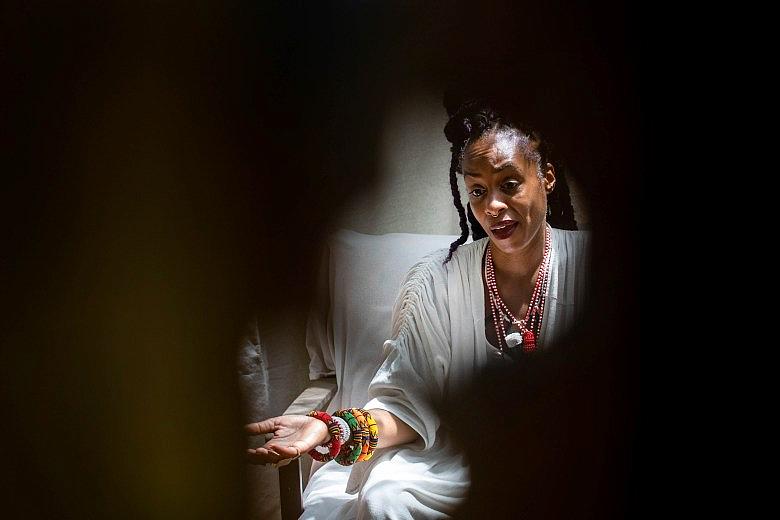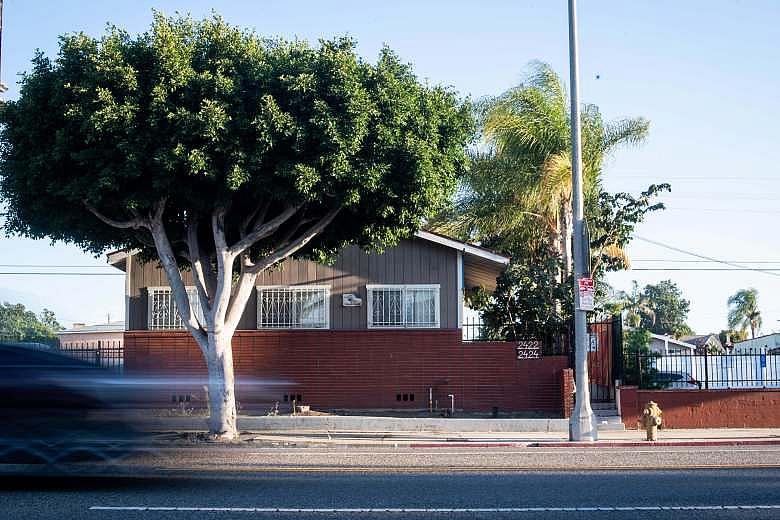Birth centers grow in popularity, but owners say it’s difficult to qualify for state license
This is the third in "Pregnant During Pandemic," a series by Olga Grigoryants, a participant in the USC Annenberg Center for Health Journalism’s 2021 California Fellowship.
Her other stories include:
Part 1: Pregnant during pandemic: Programs, midwives step up to support Black mothers
Part 2: Pregnant during Pandemic: Black midwives in demand; are there enough to handle influx of clients?
Part 4: Pregnant during pandemic: COVID-19 fears fuel increased interest in home births
Part 5: Pregnant during pandemic: Expectant mothers remain at high risk of COVID-19

Obstetrics Service Chief Dr. Mya Zapata says the birth center at Ronald Reagan UCLA Medical Center in Westwood supports all births from hypnotic to high risk births.
(Photo by Sarah Reingewirtz, Los Angeles Daily News/SCNG)
Midwife Racha Tahani Lawler sits in the space in her garden on Tuesday, July 6, 2021 where she meets with women. She once owned a community birth center but without insurance covering midwifery found it to be difficult to sustain and now does home births. (Photo by Sarah Reingewirtz, Los Angeles Daily News/SCNG)
Lawler, then a single mother of three children, transformed an old building she found on Craigslist into a welcoming space with two birth rooms, a kitchen and garden. Her 80-year-old grandmother, who lived a few blocks away, could walk to the center to support women in labor.
Lawler offered generous discounts to families who couldn’t afford to pay thousands of dollars out of pocket for an out-of-hospital birth. Some clients, she said, “were putting all their little pennies together to have a birth” at her center.
Many of Lawler’s clients were eligible for MediCal coverage, but since her center was unlicensed, the state would not reimburse her services. Lawyer tried for months to obtain a license for the center, but eventually gave up because she couldn’t afford the $5,000 cost.
A building on W. Florence Avenue was midwife Racha Tahani Lawler’s first birth center down the street from her grandmother’s home. Her grandmother, a nurse, also assisted women at the center. (Photo by Sarah Reingewirtz, Los Angeles Daily News/SCNG)
“I was using my food stamps to provide snacks in the birth center and growing a garden to make sure my clients were eating,” she said.
Running the center without insurance reimbursements proved to be unsustainable and burdensome. Stressed and burned out, Lawler closed the birth center in 2016.
Licenses difficult to obtain
As a licensed midwife, it is not against the law to operate an unlicensed birth center. But to bill MediCal for its services, midwives are required to license their facilities. Experts, however, say stringent state laws are hurting birth center operators and the low-income families they serve.
“There are a lot of regulations and licensing for birth centers, which make it very difficult to become licensed,” said Kathleen Belzer, president of the California Nurse-Midwives Foundation.
The process is so convoluted, Belzer added, that it might take up to three years for some midwives to license their facilities. One example of the bureaucratic nightmare they face involves the Comprehensive Prenatal Service Providers program, or CPSP, designed to increase services available to women and boost reimbursement available to birth centers. To get a license, birth centers are required to be part of the program. But to become a CPSP provider, birth centers have to have a license.
A spokesperson for the California Department of Public Health wrote in an email that “alternative birthing centers must meet a set of requirements in order to receive a license. These requirements are designed per state legislation to ensure every mother and child receive safe, high-quality care while in the facility.”
Why birth centers?
Women opt for giving birth at birth centers because they offer a home-like setting where patients are allowed to move around during labor and bring family members and children. Giving birth at the birth centers typically saves up to $2,000 per family, although the amount depends on insurance coverage.
While operating independently, birth centers that meet the standards of the American Association of Birth Centers, or AABC, are integrated within the health care system so they can transfer clients to a hospital in case of emergency. Midwives who have hospital privileges can continue caring for their clients in such instances.
Nationwide, about 0.3% of births take place in birth centers, according to AABC. Only healthy and low-risk women are eligible for delivery at birth centers.
A 2013 study of about 22,400 women who planned to give birth in a birth center accredited by the Commission for the Accreditation of Birth Centers found that 94% of women who entered labor achieved a vaginal birth and only 6% were transferred to a hospital for a C-section.
In contrast, about 26% of healthy, low-risk pregnancies in hospitals end up with C-sections, according to a 2017 Consumer Report study.
Another study conducted by the Centers for Medicare and Medicaid Services from 2013 to 2017 discovered that birth centers, coupled with a midwifery model of care, resulted in lower rates of preterm birth, lower rates of low birth weight and lower rates of C-sections.
Neither the California Department of Public Health nor the Medical Board of California tracks the number of birth centers in Southern California. The Los Angeles County Department of Public Health also doesn’t collect that data.
Exasperation at state regulations
Across the state, midwives say they have grown weary of the roadblocks they face in California to license their birth centers.
When Bethany Sasaki opened her Midtown Nurse Midwives birth center in Sacramento, she tried to do everything by the book. She received national accreditation, but her California licensing application was still rejected by the state because the building that housed her center was too old.
“There are systems in place in California that make it almost impossible to have a birth center,” Sasaki said. “It’s like a never-ending cycle.”
The California Department of Public Health, which handles the licensure process, recently changed the building code criteria for birth centers, she added, requiring the same rigid standards for them as hospitals.
“No one is going to get a license until we change it,” she said. “It’s just a nightmare.”
When Sasaki was launching the California chapter of AABC, she reached out to birth centers to join the organization and discovered that out of 45 centers across the state, only nine had a license.
Sasaki, who is now president of the California chapter, said the difficult licensing process is hurting MediCal recipients.
“We have a big problem in the state of California with birth center licenses,” she said. “We need to be able to license birth centers so they can be medical providers, so they can serve underserved communities.”
Accreditation ensures safety
Still, the American College of Obstetricians and Gynecologists said accredited birth centers and hospitals are the safest places to give birth.
Dr. Mya Zapata, an obstetrician and gynecologist and the chief of the obstetrics service at Ronald Reagan Medical Center at UCLA, said she wouldn’t recommend attending an unlicensed birth center.
“Licenses mean oversight,” she said, “And that the individuals that are running that center are going to follow standards to keep that family safe. … And in the event of an emergency, they have the means to get that patient to a higher level of care in an expedited manner.”
She recommended asking birth center owners how they handle emergencies.
“In the case that there was something unexpected, an emergency such as bleeding or something happening with the baby,” she said, “how would you handle it? What are your tools and what is your plan when you need assistance to help with a complex situation?”
‘Sacrificing everything’
Lawler felt proud that she was able to open a birth center that predominantly served Black women, who are about four times more likely to die during pregnancy or childbirth than White women.
As she talks about the center closure, Lawler tries not to be bitter.
“The whole entire time it was open, it was there to serve the community,” she said. “It was to fill in where there wasn’t a place for so many people that were wanting out-of-hospital birth. It made out-of-hospital birth accessible for a lot of people, but I literally was sacrificing everything in order for it to exist.”
A painted yard sign sits outside a building on La Cienega Boulevard in Los Angeles which was once Midwife Racha Tahani Lawler’s dream, a birth center for the black community. (Photo by Sarah Reingewirtz, Los Angeles Daily News/SCNG)
Belzer, of the California Nurse-Midwives Foundation, said she was putting together a group of midwives to push for easing the licensing process for birth centers.
The hurdles to obtain a license impact not just low-income women who want to give birth, she said, but also midwives who are willing to help them. Belzer’s foundation also advocates for sustainable MediCal reimbursement rates for birth centers.
“They lose money or break even on most MediCal patients so they do it because they know it’s the right thing to do,” she said. “But it often will put birth centers in jeopardy and often birth centers were closing because of that.
“We need to create quality within the birth center community without creating barriers that are unattainable. Traditionally, people think they are creating safety for people by making it impossible to even open your doors or stay open. These things have to change.”
Olga Grigoryants’ reporting on pregnancy during the pandemic was undertaken as a project for the USC Center for Health Journalism’s 2021 California Fellowship.
[This article was originally published by Los Angeles Daily News.]

